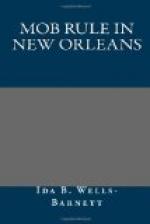July 22, 1893, at Memphis, Tenn., the body of Lee Walker was dragged through the street and burned before the court house. Walker had frightened some girls in a wagon along a country road by asking them to let him ride in their wagon. They cried out; some men working in a field near by said it was at attempt of assault, and of course began to look for their prey. There was never any charge of rape; the women only declared that he attempted an assault. After he was apprehended and put in jail and perfectly helpless, the mob dragged him out, shot him, cut him, beat him with sticks, built a fire and burned the legs off, then took the trunk of the body down and dragged further up the street, and at last burned it before the court house.
Sept. 20, 1893, at Roanoke, Va., the body of a Negro who had quarreled with a white woman was burned in the presence of several thousand persons. These people also wreaked their vengeance upon this helpless victim of the mob’s wrath by sticking knives into him, kicking him and beating him with stones and otherwise mutilating him before life was extinct.
June 11, 1898, at Knoxville, Ark., James Perry was shut up in a cabin because he had smallpox and burned to death. He had been quarantined in this cabin when it was declared that he had this disease and the doctor sent for. When the physician arrived he found only a few smoldering embers. Upon inquiry some railroad hands who were working nearby revealed the fact that they had fastened the door of the cabin and set fire to the cabin and burned man and hut together.
Feb. 22, 1898, at Lake City, S.C., Postmaster Baker and his infant child were burned to death by a mob that had set fire to his house. Mr. Baker’s crime was that he had refused to give up the post office, to which he had been appointed by the National Government. The mob had tried to drive him away by persecution and intimidation. Finding that all else had failed, they went to his home in the dead of night and set fire to his house, and as the family rushed forth they were greeted by a volley of bullets. The father and his baby were shot through the open door and wounded so badly that they fell back in the fire and were burned to death. The remainder of the family, consisting of the wife and five children, escaped with their lives from the burning house, but all of them were shot, one of the number made a cripple for life.
Jan. 7, 1898, two Indians were tied to a tree at Maud Post Office, Indian Territory, and burned to death by a white mob. They were charged with murdering a white woman. There was no proof of their guilt except the unsupported word of the mob. Yet they were tied to a tree and slowly roasted to death. Their names were Lewis McGeesy and Hond Martin. Since that time these boys have been found to be absolutely innocent of the charge. Of course that discovery is too late to be of any benefit to them, but because they were Indians the Indian Commissioner demanded and received from the United States Government an indemnity of $13,000.




